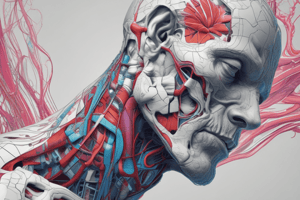Podcast
Questions and Answers
What is the most complex level of organization in the human body?
What is the most complex level of organization in the human body?
- Organ level
- Cellular level
- Tissue level
- Organ system level (correct)
Which cavity contains the heart and lungs?
Which cavity contains the heart and lungs?
- Pelvic cavity
- Thoracic cavity (correct)
- Cranial cavity
- Abdominal cavity
What directional term describes a structure that is towards the midline of the body?
What directional term describes a structure that is towards the midline of the body?
- Medial (correct)
- Lateral
- Superior
- Inferior
Which region of the body includes the arm, forearm, and hand?
Which region of the body includes the arm, forearm, and hand?
What is the term for the study of the structure of the body?
What is the term for the study of the structure of the body?
Which level of organization consists of groups of similar cells performing a specific function?
Which level of organization consists of groups of similar cells performing a specific function?
Flashcards are hidden until you start studying
Study Notes
Organization of the Body
- The human body is organized into several levels, from simplest to most complex:
- Chemical level: atoms, molecules
- Cellular level: cells, the basic structural and functional units of the body
- Tissue level: groups of similar cells performing a specific function
- Organ level: structures composed of two or more types of tissues
- Organ system level: groups of organs working together to perform a specific function
- Organismal level: the entire human body
Body Cavities
- The body has several cavities that provide protection and support for internal organs:
- Cranial cavity: contains the brain
- Thoracic cavity: contains the heart, lungs, and major blood vessels
- Abdominal cavity: contains the digestive organs
- Pelvic cavity: contains the reproductive organs and urinary bladder
Directional Terms
- Used to describe the location of body structures:
- Anterior (front) vs. posterior (back)
- Superior (upper) vs. inferior (lower)
- Medial (toward the midline) vs. lateral (away from the midline)
- Proximal (near the trunk) vs. distal (away from the trunk)
- Superficial (near the surface) vs. deep (away from the surface)
Body Regions
- Divided into several regions:
- Head: includes the face, cranium, and brain
- Neck: connects the head to the thorax
- Thorax: contains the chest and upper back
- Abdomen: contains the digestive organs
- Pelvis: contains the reproductive organs and urinary bladder
- Upper limb: includes the arm, forearm, and hand
- Lower limb: includes the thigh, leg, and foot
Organization of the Body
- The human body is organized into six levels of complexity, ranging from simplest to most complex: atoms, cells, tissues, organs, organ systems, and the entire organism.
- Chemical level consists of atoms and molecules.
- Cellular level is made up of cells, the basic structural and functional units of the body.
- Tissue level consists of groups of similar cells performing a specific function.
- Organ level consists of structures composed of two or more types of tissues.
- Organ system level consists of groups of organs working together to perform a specific function.
- Organismal level refers to the entire human body.
Body Cavities
- The body has four main cavities that provide protection and support for internal organs.
- Cranial cavity contains the brain.
- Thoracic cavity contains the heart, lungs, and major blood vessels.
- Abdominal cavity contains the digestive organs.
- Pelvic cavity contains the reproductive organs and urinary bladder.
Directional Terms
- Directional terms are used to describe the location of body structures.
- Anterior refers to the front of the body.
- Posterior refers to the back of the body.
- Superior refers to the upper part of the body.
- Inferior refers to the lower part of the body.
- Medial refers to the midline of the body.
- Lateral refers to the sides of the body.
- Proximal refers to the part of the body closest to the trunk.
- Distal refers to the part of the body farthest from the trunk.
- Superficial refers to the surface of the body.
- Deep refers to the internal parts of the body.
Body Regions
- The body can be divided into several regions.
- The head includes the face, cranium, and brain.
- The neck connects the head to the thorax.
- The thorax contains the chest and upper back.
- The abdomen contains the digestive organs.
- The pelvis contains the reproductive organs and urinary bladder.
- The upper limb includes the arm, forearm, and hand.
- The lower limb includes the thigh, leg, and foot.
Studying That Suits You
Use AI to generate personalized quizzes and flashcards to suit your learning preferences.



